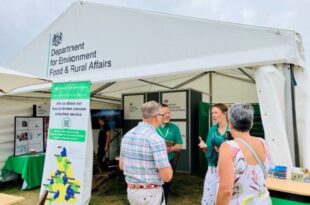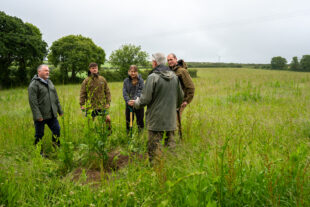https://defrafarming.blog.gov.uk/create-cultivated-margins-and-plots-for-arable-plants/
Create cultivated margins and plots for arable plants
The guidance on this page is for SFI pilot participants only. Please visit GOV.UK for the official Sustainable Farming Incentive scheme guidance.
Find out how land managers can help rare arable flowers to grow by creating uncropped areas.
If you’re completing this action as part of the Sustainable Farming Incentive pilot, how you do it is up to you.
The advice on this page can help you get better environmental and business benefits, but you do not have to follow it to get paid.
Arable plants
Arable plants are wildflowers that grow on land usually used for crops. Their seeds can survive for years in the soil. Many species are threatened and declining.
Arable plants include species like:
- corn buttercup
- field madder
- dwarf spurge
You can manage land in a way that encourages arable plants to reappear. Cultivated areas are easy to establish. You don’t sow a crop. The annual disturbance created by cultivation helps buried arable seeds germinate.
Find out if you have arable plants on your land
Good places to look for arable plants are those without crop treatments, like:
- the outer edges of a field of broad-leaved crops
- on tracks
- at the base of telegraph poles
Benefits of cultivated margins or plots
Uncropped cultivated areas give arable plants space to grow. This will:
- provide food for pollinators like bees and wasps
- provide nest sites and food for birds like corn bunting
- stop them disappearing from the landscape
Where to cultivate land for arable plants
You can create cultivated areas as field margins or larger plots, on a part or whole field basis. Field margins should be at least 6 metres wide.
Soil type
Arable plants are found on a range of soil types. Some species prefer sandy, acidic soils, while some prefer chalk or clay soils. Others can flourish on any soil type. The arable plant management guide from the Plantlife website will tell you which species are likely to be found in your soil.
If you know you have arable plants
Cultivate the areas where you already have existing arable plants. This will help maintain or increase the population. Locate big plots where there are many arable plants over a large area.
This is most important for threatened or priority arable plants, including plants on the Section 41 priority species list. Find out more about some of these threatened plants. Interrupted brome, darnel and thorow wax are also priority species.
Keeping your plots or margins in the same place every year will:
- build up the seed bank
- reduce soil nutrients, so there will be less competition from weeds
If you do not know if you have arable plants
To increase your chances of finding dormant seeds, create your plots in:
- open, sunny locations
- the outermost 6 metres of your fields, as tracks and boundaries often have the richest seed bank
- areas at the top of slopes, as the soil is often shallow and the subsoil less fertile and productive
- fields that have a long history of cultivation – arable plant seeds can survive for long periods in the soil
You need to avoid:
- cool, north facing shaded locations, as most seeds will not germinate
- places with perennial and arable grass weed problems
You can move margins every 3 years. This will help you find new areas of arable plant seeds. Moving your plots around can minimise weeds and crop diseases. You can fit this in with your existing crop rotation.
How to establish cultivated areas
You can create cultivated areas using existing farm machinery, like a plough or power harrow.
Produce a fine, firm bed across the plot.
Some arable plants need to be managed in a specific way to enable them to grow. If you know which arable plants are present, read the arable plant management guide. This will help you establish areas in the best way for the species you have.
If you do not know what plants you have, vary the cultivation depth to encourage a variety of species. Cultivate between 5cm and 15cm deep. Use a rotovator or a power harrow to cultivate to 5cm depth. You can use a plough to cultivate to a depth of 15cm. Aim to do this every 2 to 3 years.
Leave a buffer of 4 metres between cultivated areas and hedgerows.
Do not cultivate deeper than the previous cultivation on any below-ground historic features.
When to cultivate
If you know what arable plants you have, the arable plant management guide from the Plantlife website will tell you the best time to create uncropped areas each year.
Some species germinate in the spring or autumn. Others will germinate in both seasons.
If you have plants that germinate in the spring and the autumn, cultivate different plots at different times each year. This should help you grow the widest mix of species.
If you don’t know what arable plants you have, alternate your cultivated areas between spring one year, and autumn the following year. This will encourage a wider range of species.
You’ll need to time your cultivation annually. Cultivate:
- between February and April for spring germination
- between September and November for autumn germination
Leave the cultivated areas undisturbed until the end of August. This will allow most species to complete their life cycle and set seed.
Do not use insecticides on the cultivated areas.
Fertiliser
Avoid using fertiliser. This will help arable plants emerge without too much competition from plants like:
- blackgrass
- couch grass
- creeping thistle
- nettles
A buffer of at least 0.5 metres around uncropped areas can help prevent fertiliser spreading from crops.
Weed control
Cultivated areas may see weeds grow quickly in the first year. Over time, as nutrient levels decrease, so will the weeds.
To control weeds, you can:
- vary cultivation timing every 2 to 3 years, as this will control coarse grasses like sterile brome
- vary cultivation depth every 2 to 3 years, as this will bury weed seeds
- relocate plots to areas with a lower weed burden, unless rare localised species are present
- top them by cutting to a height of 30cm in late June and early July (only when weed species are dominating the area)
- regularly remove by hand in later June and early July (suitable for small areas)
You can:
- spot treat with herbicide using a knapsack sprayer or hand-lance in late June and early July, before seeds have ripened
- use herbicide from the beginning of September before you recultivate, to control weeds like fat hen, thistles and mugwort
- use graminicide in March or October to control coarse grasses
Some species like fescues can tolerate some graminicides. Contact an agronomist if you need more information.
What a successful cultivated margin or plot looks like
You’ll see:
- arable plants every year from mid-April until the end of August
- open patches between the plants, with some bare areas and shorter vegetation giving birds easy access to seeds on the ground
- bees, wasps, hoverflies and butterflies



